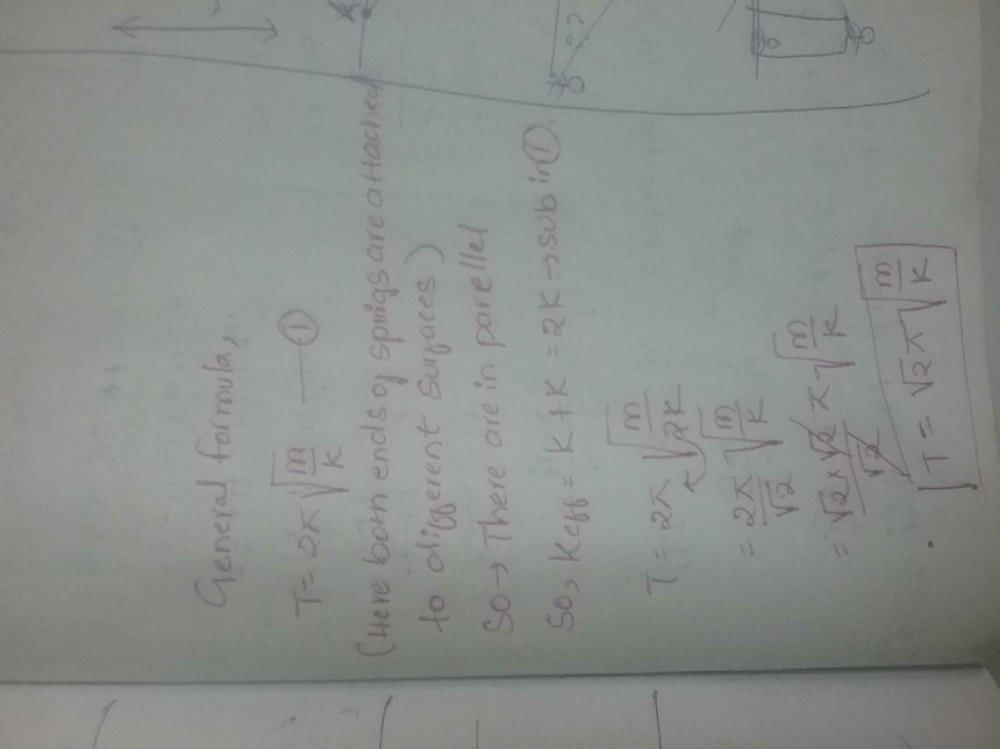All Exams >
NEET >
Topic-wise MCQ Tests for NEET >
All Questions
All questions of Oscillations for NEET Exam
Find the amplitude of the S.H.M whose displacement y in cm is given by equation y= 3sin 157t +4cos157t where t is time in seconds.- a)20Hz
- b)25Hz
- c)50Hz
- d)40Hz
Correct answer is option 'B'. Can you explain this answer?
Find the amplitude of the S.H.M whose displacement y in cm is given by equation y= 3sin 157t +4cos157t where t is time in seconds.
a)
20Hz
b)
25Hz
c)
50Hz
d)
40Hz

|
Pioneer Academy answered |
When the displacement of a SHM is:
y=a sin wt+ b cos wt
y=a sin wt+ b cos wt
- Amplitude of the SHM will be:
A=√a2+b2
Here, a = 3, b = 4
Amplitude, A= √(32+42) = 5 cm
Amplitude, A= √(32+42) = 5 cm
Hence option B is correct.
Two identical spring, each of stiffness k are welded to each other at point P. The other two ends are fixed to the edge of a smooth horizontal tube as shown. A particle of mass m is welded at P. The entire system is horizontal. The period of oscillation of the particle in the direction of x is 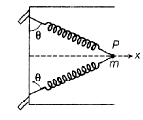
- a)

- b)

- c)

- d)

Correct answer is option 'D'. Can you explain this answer?
Two identical spring, each of stiffness k are welded to each other at point P. The other two ends are fixed to the edge of a smooth horizontal tube as shown. A particle of mass m is welded at P. The entire system is horizontal. The period of oscillation of the particle in the direction of x is 
a)
b)
c)
d)

|
Mohit Rajpoot answered |
Let us assume a force dF is applied at P in positive x - direction. This will stretch each spring by dl inducing a spring force dFs in each spring.
Let the static deformation of the system is dx (along the x-direction). The particle is in equilibrium. So,
Using Pythagoras theorem,
Here y is constant.
A second pendulum is mounted in a space shuttle. Its period of oscillations will decrease when rocket is- a)moving in geostationary orbit
- b)ascending up with uniform acceleration
- c)descending down with uniform acceleration
- d)moving up with uniform velocity
Correct answer is option 'B'. Can you explain this answer?
A second pendulum is mounted in a space shuttle. Its period of oscillations will decrease when rocket is
a)
moving in geostationary orbit
b)
ascending up with uniform acceleration
c)
descending down with uniform acceleration
d)
moving up with uniform velocity

|
Top Rankers answered |
- Time Period, T = 2π √(l/g')where,
l = Length of seconds pendulum
g’ = Apparent Gravity - For the period of oscillations of Seconds Pendulum to decrease, the Apparent gravity (g’) has to increase because:

- Hence, Time Period of oscillations of Seconds Pendulum will decrease when the rocket is ascending up with uniform acceleration.
If a simple pendulum oscillates with an amplitude 50 mm and time period 2s, then its maximum velocity isa)0.15 m/sb)0.1 m/sc)0.16 m/sd)0.8 m/sCorrect answer is option 'A'. Can you explain this answer?
|
|
Neha Joshi answered |
We know that in a simple harmonic motion the maximum velocity,
Vmax = A⍵
Here A = 50 mm
Vmax = A⍵
Here A = 50 mm
And ⍵ = 2π / T
= 2π / 2
= π
= 2π / 2
= π
Hence Vmax = 50 x 10-3.π
= 0.15 m/s
= 0.15 m/s
The displacement of a particle along the x-axis is given by x = a sin2ωt. The motion of the particle corresponds to: [2010]
- a) non simple harmonic motion
- b)simple harmonic motion of frequency 3ω /2π
- c)simple harmonic motion of frequency ω /π
- d)simple harmonic motion of frequency ω /2π
Correct answer is option 'A'. Can you explain this answer?
The displacement of a particle along the x-axis is given by x = a sin2ωt. The motion of the particle corresponds to: [2010]
a)
non simple harmonic motion
b)
simple harmonic motion of frequency 3ω /2π
c)
simple harmonic motion of frequency ω /π
d)
simple harmonic motion of frequency ω /2π
|
|
Athira Krishnana answered |
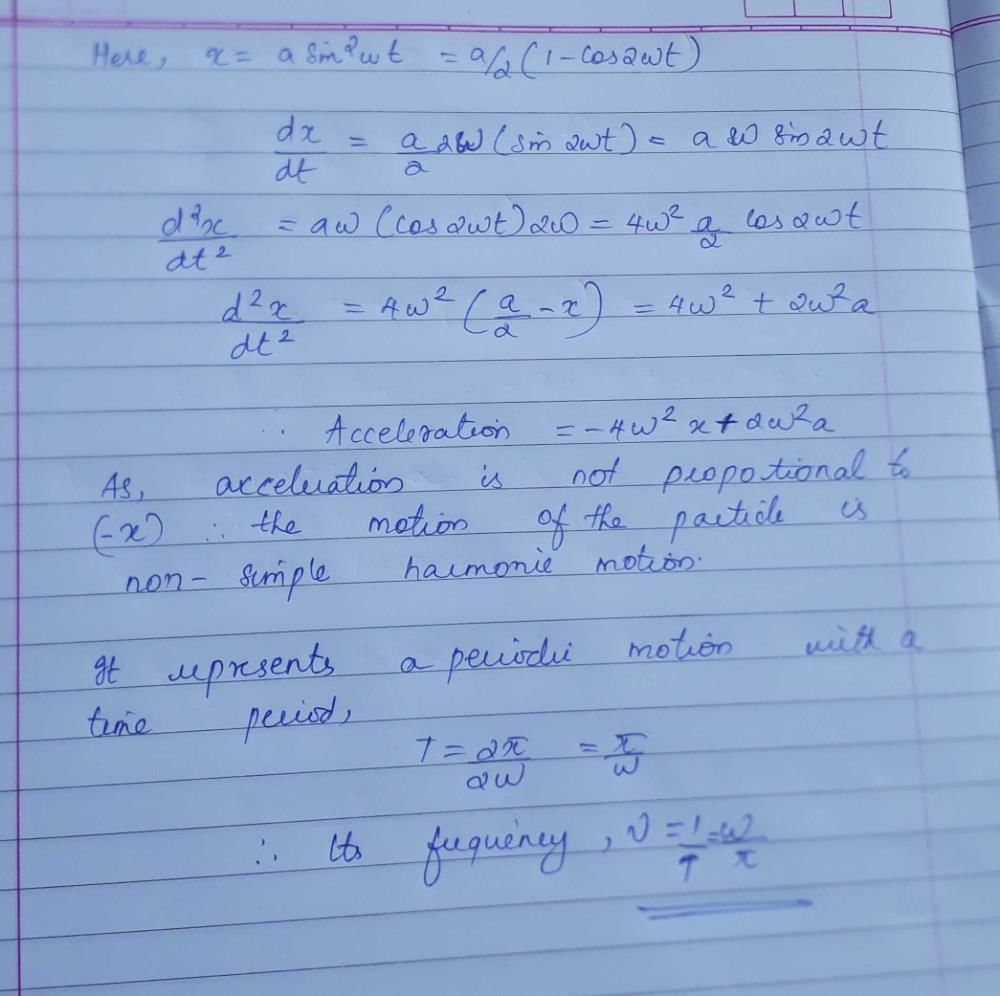
What will be the phase difference between bigger pendulum (with time period 5T/4 )and smaller pendulum (with time period T) after one oscillation of bigger pendulum?- a)π/4
- b)π/2
- c)π/3
- d)π
Correct answer is option 'B'. Can you explain this answer?
What will be the phase difference between bigger pendulum (with time period 5T/4 )and smaller pendulum (with time period T) after one oscillation of bigger pendulum?
a)
π/4
b)
π/2
c)
π/3
d)
π
|
|
Preeti Iyer answered |
By the time bigger pendulum completes one vibration, the smaller pendulum would have completed 5/4 vibrations. That is smaller pendulum will be ahead by 1/4 vibration in phase. 1/4 vibration means λ/4 path or π/2 radians.
A frequency of 1Hz corresponds to:- a)2 vibrations per second
- b)1 vibration per second
- c)10 vibrations per second
- d)a time period of ½ second
Correct answer is option 'B'. Can you explain this answer?
A frequency of 1Hz corresponds to:
a)
2 vibrations per second
b)
1 vibration per second
c)
10 vibrations per second
d)
a time period of ½ second
|
|
Alok Mehta answered |
Frequency used to be measured in cycles per second, but now we use the unit of frequency - the Hertz (abbreviated Hz). One Hertz (1Hz) is equal to one vibration per second. So the weight above is bouncing with a frequency of about 1Hz. The sound wave corresponding to Middle C on a piano is around 256Hz.
What determines the natural frequency of a body?- a)Position of the body with respect to force applied
- b)Mass and speed of the body
- c)Oscillations in the body
- d)Elastic properties and dimensions of the body
Correct answer is option 'D'. Can you explain this answer?
What determines the natural frequency of a body?
a)
Position of the body with respect to force applied
b)
Mass and speed of the body
c)
Oscillations in the body
d)
Elastic properties and dimensions of the body
|
|
Lavanya Menon answered |
Natural frequency is the frequency at which a body tends to oscillate in the absence of any driving or damping force.
Free vibrations of any elastic body are called natural vibration and happen at a frequency called natural frequency. Natural vibrations are different from forced vibration which happen at frequency of applied force .
Free vibrations of any elastic body are called natural vibration and happen at a frequency called natural frequency. Natural vibrations are different from forced vibration which happen at frequency of applied force .
A particle executes linear simple harmonic motion with an amplitude of 2 cm. When the particle is at 1 cm from the mean position, the magnitude of its velocity is equal to that of its acceleration. Then its time period in seconds is:- a)2π/√3
- b)2π√3
- c)√3/2π
- d)1/ 2π√3
Correct answer is option 'A'. Can you explain this answer?
A particle executes linear simple harmonic motion with an amplitude of 2 cm. When the particle is at 1 cm from the mean position, the magnitude of its velocity is equal to that of its acceleration. Then its time period in seconds is:
a)
2π/√3
b)
2π√3
c)
√3/2π
d)
1/ 2π√3
|
|
Jyoti Kapoor answered |
velocity at distance x in shm is given as
v= w sqrt(A2-x2)
so A = 2 x =1
v = w sqrt(4-1) = wsqrt3
now acc at distance x is a= w2 x = w2
as mag a = mag v
w2 = wsqrt3
w= sqrt3
2pi/T= sqrt3
T = 2pi/sqrt3
If  is the natural frequency of the system and
is the natural frequency of the system and  is the frequency of the external force that acts on an oscillating system then at resonance
is the frequency of the external force that acts on an oscillating system then at resonance- a)ωd ≥ ω
- b)ωd = ω
- c)ωd ≤ ω
- d)ωd ≠ ω
Correct answer is option 'B'. Can you explain this answer?
If  is the natural frequency of the system and
is the natural frequency of the system and  is the frequency of the external force that acts on an oscillating system then at resonance
is the frequency of the external force that acts on an oscillating system then at resonance
 is the natural frequency of the system and
is the natural frequency of the system and  is the frequency of the external force that acts on an oscillating system then at resonance
is the frequency of the external force that acts on an oscillating system then at resonancea)
ωd ≥ ω
b)
ωd = ω
c)
ωd ≤ ω
d)
ωd ≠ ω
|
|
Om Desai answered |
When the natural frequency and external frequency of an object are equal the phenomenon is called resonance.
A wave has S.H.M (Simple Harmonic Motion) whose period is 4 seconds while another wave which also possess SHM has its period 3 seconds. If both are combined, then the resultant wave will have the period equal to [1993]- a)4 seconds
- b)5 seconds
- c)12 seconds
- d)3 seconds
Correct answer is option 'C'. Can you explain this answer?
A wave has S.H.M (Simple Harmonic Motion) whose period is 4 seconds while another wave which also possess SHM has its period 3 seconds. If both are combined, then the resultant wave will have the period equal to [1993]
a)
4 seconds
b)
5 seconds
c)
12 seconds
d)
3 seconds
|
|
Siddheshwar Kale answered |
When wave in SHM combined beat will produce.
combine f= f2-f1= 1/T1 - 1/T2= 1/T=1/3 -1/4= 1/12.
since, T=12.
combine f= f2-f1= 1/T1 - 1/T2= 1/T=1/3 -1/4= 1/12.
since, T=12.
The restoring force in a simple harmonic motion is _________ in magnitude when the particle is instantaneously at rest.- a)zero
- b)maximum
- c)minimum
- d)none of these
Correct answer is option 'B'. Can you explain this answer?
The restoring force in a simple harmonic motion is _________ in magnitude when the particle is instantaneously at rest.
a)
zero
b)
maximum
c)
minimum
d)
none of these

|
Knowledge Hub answered |
The restoring force in a simple harmonic motion is maximum in magnitude when the particle is instantaneously at rest because in SHM object’s tendency is to return to mean position and here particle is instantaneously at rest after that instant restoring force will be max to bring particle to mean position.
A simple harmonic oscillator has an amplitude A and time period T. The time required by it to travel from x = A to x = A/2 is [1992]- a)T/6
- b)T/4
- c)T/3
- d)T/2
Correct answer is option 'A'. Can you explain this answer?
A simple harmonic oscillator has an amplitude A and time period T. The time required by it to travel from x = A to x = A/2 is [1992]
a)
T/6
b)
T/4
c)
T/3
d)
T/2
|
|
Geetika Shah answered |
For S.H.M.,

When x = A, 



When

or, 

Now, time taken to travel from x = A to x = A/2 is (T/4 – T/12) = T/6
If an external force with angular frequency ωd acts on an oscillating system with natural angular frequency ω, the system oscillates with angular frequency ωd. The amplitude of oscillations is the greatest when:- a)ωd > ω
- b)ωd < ω
- c)ωd ≥ ω
- d)ωd = ω
Correct answer is option 'D'. Can you explain this answer?
If an external force with angular frequency ωd acts on an oscillating system with natural angular frequency ω, the system oscillates with angular frequency ωd. The amplitude of oscillations is the greatest when:
a)
ωd > ω
b)
ωd < ω
c)
ωd ≥ ω
d)
ωd = ω
|
|
Jyoti Aiims Aspirant answered |
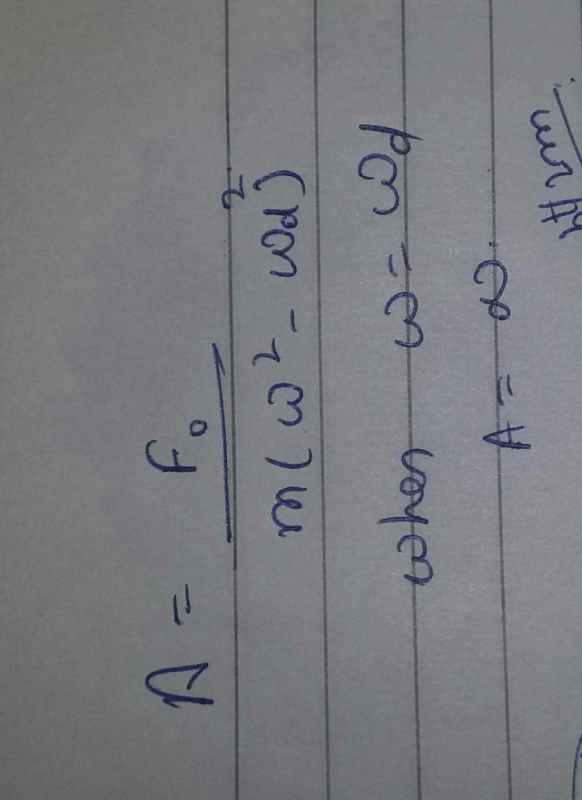
The composition of two simple h ar monic motions of equal periods at right angle to each other and with a phase difference of π results in the displacement of the particle along [1990]- a)circle
- b)figures of eight
- c)straight line
- d)ellipse
Correct answer is option 'C'. Can you explain this answer?
The composition of two simple h ar monic motions of equal periods at right angle to each other and with a phase difference of π results in the displacement of the particle along [1990]
a)
circle
b)
figures of eight
c)
straight line
d)
ellipse

|
Aaksc Chemistry answered |

It is an equation of a straight line.
Under what condition angular frequency ω of the damped oscillator would be equivalent to angular velocity Ω of the undamped oscillator.- a)Velocity of oscillator is small
- b)Damping constant, b is small
- c)Damping constant ,b is large
- d)Force applied is small
Correct answer is option 'B'. Can you explain this answer?
Under what condition angular frequency ω of the damped oscillator would be equivalent to angular velocity Ω of the undamped oscillator.
a)
Velocity of oscillator is small
b)
Damping constant, b is small
c)
Damping constant ,b is large
d)
Force applied is small
|
|
Priya Patel answered |
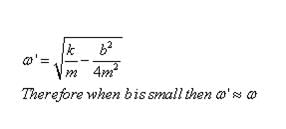
A particle of mass 0.1 kg is executing SHM of amplitude 0.1 m. When the particle passes through the mean position, its KE is 8 ×10-3 J. Find the equation of motion of the particle if the initial phase of oscillation is 45˚- a)y = 0.1 cos(3t + (π/4))
- b)y = 0.1 sin(6t + (π/4))
- c)y = 0.1 sin(4t + (π/4))
- d)y=0.1 cos(4t + (π/4))
Correct answer is option 'C'. Can you explain this answer?
A particle of mass 0.1 kg is executing SHM of amplitude 0.1 m. When the particle passes through the mean position, its KE is 8 ×10-3 J. Find the equation of motion of the particle if the initial phase of oscillation is 45˚
a)
y = 0.1 cos(3t + (π/4))
b)
y = 0.1 sin(6t + (π/4))
c)
y = 0.1 sin(4t + (π/4))
d)
y=0.1 cos(4t + (π/4))

|
Trisha Vashisht answered |
According to question
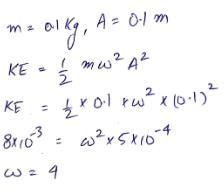
By substituting the value we the final equation


By substituting the value we the final equation

The amplitude of a pendulum executing damped simple harmonic motion falls to 1/3 the original value after 100 oscillations. The amplitude falls to S times the original value after 200 oscillations, where S is [2002]- a)1/9
- b)1/2
- c)2/3
- d)1/6
Correct answer is option 'A'. Can you explain this answer?
The amplitude of a pendulum executing damped simple harmonic motion falls to 1/3 the original value after 100 oscillations. The amplitude falls to S times the original value after 200 oscillations, where S is [2002]
a)
1/9
b)
1/2
c)
2/3
d)
1/6
|
|
Santhana Priya answered |
Correct answer is option.A
In the figure shown pulley is massless. Initially the blocks are held at a height such that spring is in its natural length. The amplitude and velocity amplitude of block B1 respectively are (there is no slipping anywhere)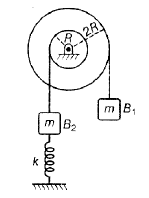
- a)

- b)

- c)

- d)

Correct answer is option 'A'. Can you explain this answer?
In the figure shown pulley is massless. Initially the blocks are held at a height such that spring is in its natural length. The amplitude and velocity amplitude of block B1 respectively are (there is no slipping anywhere)
a)
b)
c)
d)

|
Muskaan Mishra answered |
Decrease in GPE of B1 = Increase in Gravitational PE of B2 + Increase in elastic PE of spring.
Again applying law of conservation of mechanical energy at the mean position we get
The potential energy of a long spring when stretched by 2cm is U. If the spring is stretched by 8 cm, the potential energy stored in it is- a)8 U
- b)16 U [2006]
- c)U/ 4
- d)4 U
Correct answer is option 'B'. Can you explain this answer?
The potential energy of a long spring when stretched by 2cm is U. If the spring is stretched by 8 cm, the potential energy stored in it is
a)
8 U
b)
16 U [2006]
c)
U/ 4
d)
4 U
|
|
Geetika Shah answered |
The potential energy of a spring


For x = 8 cm,
Energy stored


Which one of the following is a simple harmonic motion? [1994]- a)Ball bouncing between two rigid vertical walls
- b)Particle moving in a circle with uniform speed
- c)Wave moving through a string fixed at both ends
- d)Earth spinning about its own axis.
Correct answer is option 'C'. Can you explain this answer?
Which one of the following is a simple harmonic motion? [1994]
a)
Ball bouncing between two rigid vertical walls
b)
Particle moving in a circle with uniform speed
c)
Wave moving through a string fixed at both ends
d)
Earth spinning about its own axis.

|
Pankaj Kulkarni answered |
A wave moving through a string fixed at both ends, is a transverse wave formed as a result of simple harmonic motion of particles of the string.
If the length of a simple pendulum is increased by 2%, then the time period [1997]- a)increases by 2%
- b)decreases by 2%
- c)increases by 1%
- d)decreases by 1%
Correct answer is option 'C'. Can you explain this answer?
If the length of a simple pendulum is increased by 2%, then the time period [1997]
a)
increases by 2%
b)
decreases by 2%
c)
increases by 1%
d)
decreases by 1%

|
Ayesha Princess answered |
T=2π√l/g
here we take g=constant..
so T Will b proportional to √l....
for small change in length
ΔT/T=1/2Δl/l
=1/2(2%)
=1% increase (since it is directly proportional)
here we take g=constant..
so T Will b proportional to √l....
for small change in length
ΔT/T=1/2Δl/l
=1/2(2%)
=1% increase (since it is directly proportional)
The amplitude of S.H.M at resonance is _______ in the ideal case of zero damping.- a)Maximum
- b)Minimum
- c)Zero
- d)Infinite
Correct answer is option 'D'. Can you explain this answer?
The amplitude of S.H.M at resonance is _______ in the ideal case of zero damping.
a)
Maximum
b)
Minimum
c)
Zero
d)
Infinite
|
|
Neha Joshi answered |
In an ideal environment where there is no resistance to oscillation motion i.e. damping is zero, when we oscillate a system at its resonant frequency since there is no opposition to oscillation, the amplitude will go on increasing and reach infinity.
The velocity of a particle moving with simple harmonic motion is . . . . at the mean position.- a)Zero
- b)Minimum
- c)Maximum
- d)None of the above
Correct answer is option 'A'. Can you explain this answer?
The velocity of a particle moving with simple harmonic motion is . . . . at the mean position.
a)
Zero
b)
Minimum
c)
Maximum
d)
None of the above
|
|
Niharika Nair answered |
V = ω√(A2 – x2)
So the velocity is maximum at mean position
So the velocity is maximum at mean position
Two simple pendulums of length 5m and 20m respectively are given small linear displacement in one direction at the same time. They will again be in the phase when the pendulum of shorter length has completed ....... oscillations [1998]- a)5
- b)1
- c)2
- d)3
Correct answer is option 'C'. Can you explain this answer?
Two simple pendulums of length 5m and 20m respectively are given small linear displacement in one direction at the same time. They will again be in the phase when the pendulum of shorter length has completed ....... oscillations [1998]
a)
5
b)
1
c)
2
d)
3

|
Tejas Chavan answered |
Let the pendulums be in phase after t sec of start. Within this time, if the bigger pendulum executes n oscillations, the smaller one will have executed (n + 1) oscillations.
Now, the time of n oscillation = & the time of (n + 1) oscillation
& the time of (n + 1) oscillation
Now, the time of n oscillation =
 & the time of (n + 1) oscillation
& the time of (n + 1) oscillation
To be in phase

or, 2n = n + 1
or, n = 1
Hence, the no. of oscillations executed by shorter pendulum = n + 1 = 1 + 1 = 2
or, n = 1
Hence, the no. of oscillations executed by shorter pendulum = n + 1 = 1 + 1 = 2
A hollow sphere is filled with water. It is hung by a long thread. As the water flows out of a hole at the bottom, the period of oscillation will [1997]- a)first increase and then decrease
- b)first decrease and then increase
- c)go on increasing
- d)go on decreasing
Correct answer is option 'A'. Can you explain this answer?
A hollow sphere is filled with water. It is hung by a long thread. As the water flows out of a hole at the bottom, the period of oscillation will [1997]
a)
first increase and then decrease
b)
first decrease and then increase
c)
go on increasing
d)
go on decreasing
|
|
Mohit Choudhury answered |
Time period of simple pendulum
 where l is effective
where l is effectivelength. [i.e distance between centre of suspension and centre of gravity of bob]
Initially, centre of gravity is at the centre of sphere. When water leaks the centre of gravity goes down until it is half filled; then it begins to go up and finally it again goes at the centre. That is effective length first increases and then decreases. As  , so time period first increases and then decreases.
, so time period first increases and then decreases.
 , so time period first increases and then decreases.
, so time period first increases and then decreases.A particle executes simple harmonic oscillation with an amplitude a. The period of oscillation is T. The minimum time taken by the particle to travel half of the amplitude from the equilibrium position is[2007]- a)T/8
- b)T/12
- c)T/2
- d)T/4
Correct answer is option 'B'. Can you explain this answer?
A particle executes simple harmonic oscillation with an amplitude a. The period of oscillation is T. The minimum time taken by the particle to travel half of the amplitude from the equilibrium position is[2007]
a)
T/8
b)
T/12
c)
T/2
d)
T/4

|
Anu Bajaj answered |
Displacement from the mean position

According to problem y = a/2


This is the minimum time taken by the particle to travel half of the amplitude from the equilibrium position.
In the ideal case of zero damping, the amplitude of simple harmonic motion at resonance is:- a)zero
- b)infinite
- c)cannot be said
- d)varies from zero to infinite
Correct answer is option 'B'. Can you explain this answer?
In the ideal case of zero damping, the amplitude of simple harmonic motion at resonance is:
a)
zero
b)
infinite
c)
cannot be said
d)
varies from zero to infinite
|
|
Priya Patel answered |
In an ideal environment where there is no resistance to oscillatory motion, that is, damping is zero, when we oscillate a system at its resonant frequency, since there is no opposition to oscillation, a very large value of amplitude will be recorded. Forced oscillation is when you apply an external oscillating force.
A block of mass M is attached to the lower end of a vertical spring. The spring is hung from a ceiling and has force constant value k. The mass is released from rest with the spring initially unstretched. The maximum extension produced in the length of the spring will be: [2009]- a) Mg/k
- b)4 Mg/k
- c)Mg/2k
- d)2 Mg/k
Correct answer is option 'D'. Can you explain this answer?
A block of mass M is attached to the lower end of a vertical spring. The spring is hung from a ceiling and has force constant value k. The mass is released from rest with the spring initially unstretched. The maximum extension produced in the length of the spring will be: [2009]
a)
Mg/k
b)
4 Mg/k
c)
Mg/2k
d)
2 Mg/k

|
Shourya Gupta answered |
By conservation of energy theorem
mgh=1/2 kh^²
mg=1/2kh
h=2mg/k
mgh=1/2 kh^²
mg=1/2kh
h=2mg/k
There is a body having mass m and performing S.H.M. with amplitude a. There is a restoring force F = –kx. The total energy of body depends upon[2001]- a)k, x
- b)k, a
- c)k, a, x
- d)k, a, v
Correct answer is option 'B'. Can you explain this answer?
There is a body having mass m and performing S.H.M. with amplitude a. There is a restoring force F = –kx. The total energy of body depends upon[2001]
a)
k, x
b)
k, a
c)
k, a, x
d)
k, a, v
|
|
Smruti Sucharita answered |
TE= 1/2KA2
so it depends only on K and a...
so it depends only on K and a...
A point performs simple harmonic oscillation of period T and the equation of motion is given by x = a sin (ωt + π/6). After the elapse of what fraction of the time period the velocity of the point will be equal to half of its maximum velocity? [2008]
- a)T/8
- b)T/6
- c)T/3
- d)T/12
Correct answer is option 'D'. Can you explain this answer?
A point performs simple harmonic oscillation of period T and the equation of motion is given by x = a sin (ωt + π/6). After the elapse of what fraction of the time period the velocity of the point will be equal to half of its maximum velocity? [2008]
a)
T/8
b)
T/6
c)
T/3
d)
T/12
|
|
Surendra Bishnoi answered |
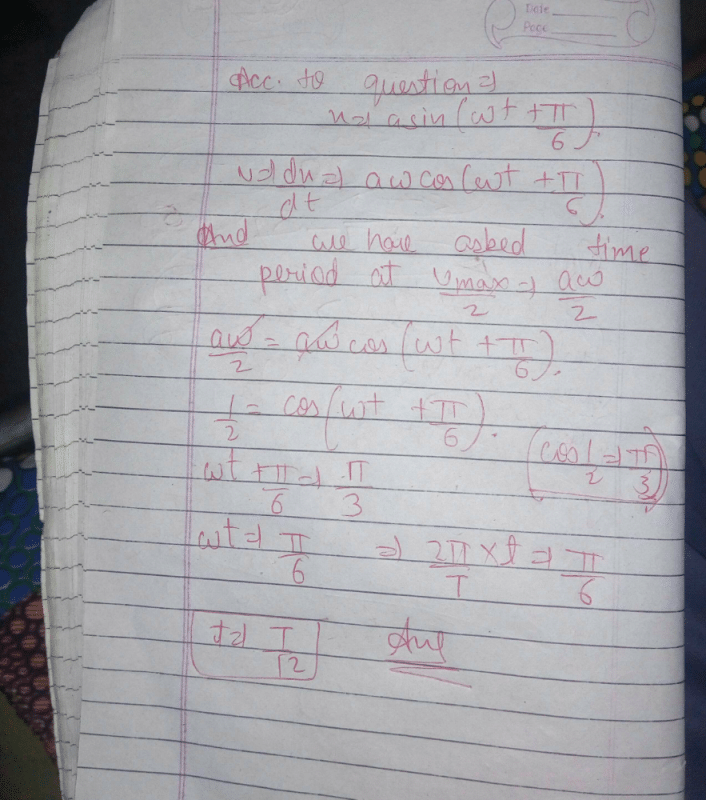
A simple pendulum has a metal bob, which is negatively charged. If it is allowed to oscillate above a positively charged metallic plate, then its time period will [2001]- a)increase
- b)decrease
- c)become zero
- d)remain the same
Correct answer is option 'B'. Can you explain this answer?
A simple pendulum has a metal bob, which is negatively charged. If it is allowed to oscillate above a positively charged metallic plate, then its time period will [2001]
a)
increase
b)
decrease
c)
become zero
d)
remain the same
|
|
Gargi Datta answered |
Explanation:
When a negatively charged metal bob is placed above a positively charged metallic plate, an electric field is created between them. This electric field exerts a force on the bob, which affects its motion and hence the time period of oscillation.
Electric Field and Force:
The positively charged metallic plate creates an electric field in the region surrounding it. This electric field points towards the plate, from the bob to the plate. Since the bob is negatively charged, it experiences a force in the direction opposite to the electric field.
Effect on Time Period:
The force exerted on the bob due to the electric field affects its motion and hence the time period of oscillation. The time period of a simple pendulum is given by:
T = 2π√(l/g)
where T is the time period, l is the length of the pendulum, and g is the acceleration due to gravity.
As the force due to the electric field opposes the motion of the bob, it effectively increases the effective length of the pendulum. This is because the bob is pushed slightly away from the plate during its oscillation. Therefore, the length of the pendulum increases, leading to an increase in the time period.
Conclusion:
Hence, when a negatively charged metal bob is allowed to oscillate above a positively charged metallic plate, its time period will decrease. Therefore, the correct answer is option 'B' - decrease.
When a negatively charged metal bob is placed above a positively charged metallic plate, an electric field is created between them. This electric field exerts a force on the bob, which affects its motion and hence the time period of oscillation.
Electric Field and Force:
The positively charged metallic plate creates an electric field in the region surrounding it. This electric field points towards the plate, from the bob to the plate. Since the bob is negatively charged, it experiences a force in the direction opposite to the electric field.
Effect on Time Period:
The force exerted on the bob due to the electric field affects its motion and hence the time period of oscillation. The time period of a simple pendulum is given by:
T = 2π√(l/g)
where T is the time period, l is the length of the pendulum, and g is the acceleration due to gravity.
As the force due to the electric field opposes the motion of the bob, it effectively increases the effective length of the pendulum. This is because the bob is pushed slightly away from the plate during its oscillation. Therefore, the length of the pendulum increases, leading to an increase in the time period.
Conclusion:
Hence, when a negatively charged metal bob is allowed to oscillate above a positively charged metallic plate, its time period will decrease. Therefore, the correct answer is option 'B' - decrease.
A pendulum has time period T for small oscillations. Now, an obstacle is situated below the
point of suspension O at a distance  The pendulum is released from rest. Throughout the motion, the moving string makes small angle with vertical. Time after which the pendulum returns back to its initial position is
The pendulum is released from rest. Throughout the motion, the moving string makes small angle with vertical. Time after which the pendulum returns back to its initial position is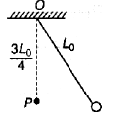
- a)T
- b)4/3T
- c)2/3T
- d)3/4T
Correct answer is option 'D'. Can you explain this answer?
A pendulum has time period T for small oscillations. Now, an obstacle is situated below the
point of suspension O at a distance The pendulum is released from rest. Throughout the motion, the moving string makes small angle with vertical. Time after which the pendulum returns back to its initial position is
The pendulum is released from rest. Throughout the motion, the moving string makes small angle with vertical. Time after which the pendulum returns back to its initial position is
point of suspension O at a distance
a)
T
b)
4/3T
c)
2/3T
d)
3/4T

|
Amrita Kumar answered |
For the right (half) oscillation, 
For the left (half) oscillation, 
The particle executing simple harmonic motion has a kinetic energy K0 cos2ωt . The maximum values of the potential energy and the total energy are respectively [2007]- a)K0/2 and K0
- b)K0 and 2K0
- c)K0 and K0
- d)0 and 2K0.
Correct answer is option 'C'. Can you explain this answer?
The particle executing simple harmonic motion has a kinetic energy K0 cos2ωt . The maximum values of the potential energy and the total energy are respectively [2007]
a)
K0/2 and K0
b)
K0 and 2K0
c)
K0 and K0
d)
0 and 2K0.
|
|
Meera Singh answered |
Given, Kinetic energy=K0cos2ωt
Maximum kinetic energy=K (as ωt=0 and cos ωt=1
Since total energy remains conserved in SHM , hence when potential energy is maximum,Kinetic energy=0 i.e. E is also equal to Umax i.e. U max(maximum potential energy) = E(Total energy) = K0
A particle of mass m oscillates along x-axis according to equation x = a sinωt. The nature of the graph between momentum and displacement of the particle is [NEET Kar. 2013]- a)straight line passing through origin
- b)circle
- c)hyper bola
- d)ellipse
Correct answer is option 'D'. Can you explain this answer?
A particle of mass m oscillates along x-axis according to equation x = a sinωt. The nature of the graph between momentum and displacement of the particle is [NEET Kar. 2013]
a)
straight line passing through origin
b)
circle
c)
hyper bola
d)
ellipse
|
|
Tarun Saha answered |
(ωt + φ), where a is the amplitude, ω is the angular frequency, t is time, and φ is the phase angle. The displacement of the particle from its equilibrium position at any time t is given by x(t) = a sin(ωt + φ).
The velocity of the particle at any time t is the derivative of the displacement with respect to time, which is given by:
v(t) = aω cos(ωt + φ)
The acceleration of the particle at any time t is the second derivative of the displacement with respect to time, which is given by:
a(t) = -aω^2 sin(ωt + φ)
The negative sign indicates that the acceleration is in the opposite direction to the displacement. This means that when the particle is at its maximum displacement, the acceleration is zero, and when the particle passes through the equilibrium position, the acceleration is maximum.
The period of the motion is the time taken by the particle to complete one full oscillation. It is given by:
T = 2π/ω
The frequency of the motion is the number of oscillations per unit time. It is given by:
f = ω/2π
The maximum velocity of the particle is given by:
v_max = aω
The maximum acceleration of the particle is given by:
a_max = aω^2
The energy of the particle is the sum of its kinetic and potential energies. At any time t, the total energy of the particle is given by:
E(t) = (1/2)mv^2 + (1/2)kx^2
where k is the spring constant. The energy is constant throughout the motion, and is equal to the total energy at any other time.
The velocity of the particle at any time t is the derivative of the displacement with respect to time, which is given by:
v(t) = aω cos(ωt + φ)
The acceleration of the particle at any time t is the second derivative of the displacement with respect to time, which is given by:
a(t) = -aω^2 sin(ωt + φ)
The negative sign indicates that the acceleration is in the opposite direction to the displacement. This means that when the particle is at its maximum displacement, the acceleration is zero, and when the particle passes through the equilibrium position, the acceleration is maximum.
The period of the motion is the time taken by the particle to complete one full oscillation. It is given by:
T = 2π/ω
The frequency of the motion is the number of oscillations per unit time. It is given by:
f = ω/2π
The maximum velocity of the particle is given by:
v_max = aω
The maximum acceleration of the particle is given by:
a_max = aω^2
The energy of the particle is the sum of its kinetic and potential energies. At any time t, the total energy of the particle is given by:
E(t) = (1/2)mv^2 + (1/2)kx^2
where k is the spring constant. The energy is constant throughout the motion, and is equal to the total energy at any other time.
Two pendulums of length 100 cm and 121 cm starts oscillating. At some instant, the two are at the mean position in the same phase. After how many oscillations of the longer pendulum will the two be in the same phase at the mean position again- a)11
- b)10
- c)21
- d)20
Correct answer is option 'B'. Can you explain this answer?
Two pendulums of length 100 cm and 121 cm starts oscillating. At some instant, the two are at the mean position in the same phase. After how many oscillations of the longer pendulum will the two be in the same phase at the mean position again
a)
11
b)
10
c)
21
d)
20
|
|
Mira Sharma answered |
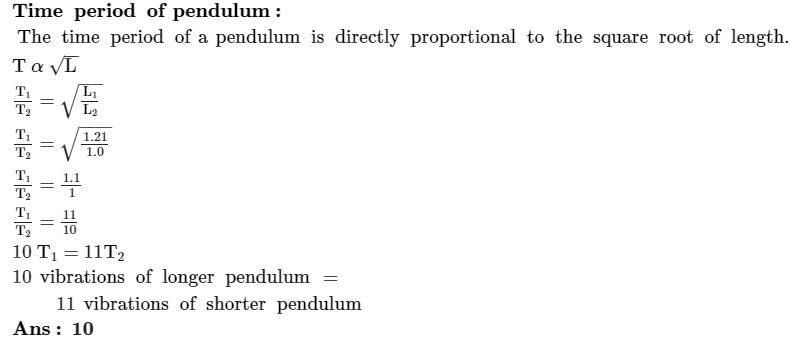
The phenomenon of increase in amplitude when the driving force is close to the natural frequency of the oscillator is known as- a)Accelerated Amplitude
- b)Epoch
- c)Resonance
- d)Dampening
Correct answer is option 'C'. Can you explain this answer?
The phenomenon of increase in amplitude when the driving force is close to the natural frequency of the oscillator is known as
a)
Accelerated Amplitude
b)
Epoch
c)
Resonance
d)
Dampening
|
|
Priya Patel answered |
The phenomenon of increase in amplitude when the driving force is close to the natural frequency of the oscillator is known as. The phenomenon of increase in amplitude when the driving force is close to the natural frequency of the oscillator is known as resonance.
Masses MA and MB hanging from the ends of strings of lengths LA and LB are executing simple harmonic motions. If their frequencies are fA = 2fB, then [2000]- a)LA = 2LB and MA = MB/2
- b)LA = 4LB regardless of masses
- c)LA = LB/4 regardless of masses
- d)LA = 2LB and MA = 2MB
Correct answer is option 'C'. Can you explain this answer?
Masses MA and MB hanging from the ends of strings of lengths LA and LB are executing simple harmonic motions. If their frequencies are fA = 2fB, then [2000]
a)
LA = 2LB and MA = MB/2
b)
LA = 4LB regardless of masses
c)
LA = LB/4 regardless of masses
d)
LA = 2LB and MA = 2MB
|
|
Devanshi Chopra answered |
To understand why the correct answer is option 'C', let's break down the given information and analyze the relationship between the frequencies and lengths of the strings.
Given:
- Masses MA and MB are hanging from strings of lengths LA and LB, respectively.
- The masses are executing simple harmonic motions.
- The frequency of MA, fA, is twice the frequency of MB, fB.
Frequency of Simple Harmonic Motion:
The frequency of an object executing simple harmonic motion is given by the formula:
f = 1/2π * √(k/m)
where f is the frequency, k is the spring constant, and m is the mass of the object.
Analyzing the Given Information:
1. Frequency Relationship:
Since fA = 2fB, we can write the equation as:
1/2π * √(kA/MA) = 2 * (1/2π * √(kB/MB))
Simplifying this equation, we get:
√(kA/MA) = 2 * √(kB/MB)
Squaring both sides of the equation, we have:
kA/MA = 4 * (kB/MB)
2. Length Relationship:
The length of a simple pendulum affects its frequency. The formula for the frequency of a simple pendulum is:
f = 1/2π * √(g/L)
where g is the acceleration due to gravity and L is the length of the pendulum.
Since the lengths of the strings are LA and LB, we can write the equation as:
1/2π * √(g/LA) = 2 * (1/2π * √(g/LB))
Simplifying this equation, we get:
√(g/LA) = 2 * √(g/LB)
Squaring both sides of the equation, we have:
g/LA = 4 * (g/LB)
Simplifying further, we can cancel out g from both sides:
1/LA = 4 * (1/LB)
LA = LB/4
Conclusion:
From the analysis above, we can conclude that the correct answer is option 'C':
LA = LB/4, regardless of the masses.
This means that the length of the string for mass A is four times smaller than the length of the string for mass B, irrespective of the masses of the objects.
Given:
- Masses MA and MB are hanging from strings of lengths LA and LB, respectively.
- The masses are executing simple harmonic motions.
- The frequency of MA, fA, is twice the frequency of MB, fB.
Frequency of Simple Harmonic Motion:
The frequency of an object executing simple harmonic motion is given by the formula:
f = 1/2π * √(k/m)
where f is the frequency, k is the spring constant, and m is the mass of the object.
Analyzing the Given Information:
1. Frequency Relationship:
Since fA = 2fB, we can write the equation as:
1/2π * √(kA/MA) = 2 * (1/2π * √(kB/MB))
Simplifying this equation, we get:
√(kA/MA) = 2 * √(kB/MB)
Squaring both sides of the equation, we have:
kA/MA = 4 * (kB/MB)
2. Length Relationship:
The length of a simple pendulum affects its frequency. The formula for the frequency of a simple pendulum is:
f = 1/2π * √(g/L)
where g is the acceleration due to gravity and L is the length of the pendulum.
Since the lengths of the strings are LA and LB, we can write the equation as:
1/2π * √(g/LA) = 2 * (1/2π * √(g/LB))
Simplifying this equation, we get:
√(g/LA) = 2 * √(g/LB)
Squaring both sides of the equation, we have:
g/LA = 4 * (g/LB)
Simplifying further, we can cancel out g from both sides:
1/LA = 4 * (1/LB)
LA = LB/4
Conclusion:
From the analysis above, we can conclude that the correct answer is option 'C':
LA = LB/4, regardless of the masses.
This means that the length of the string for mass A is four times smaller than the length of the string for mass B, irrespective of the masses of the objects.
A body is executing S .H. M . When the displacements from the mean position are 4cm and 5 cm, the corresponding velocities of the body are 10 cm per sec and 8 cm per sec. Then the time period of the body is [1991]- a)2π sec
- b)π/2 sec
- c)π sec
- d)(3π/2)sec
Correct answer is option 'C'. Can you explain this answer?
A body is executing S .H. M . When the displacements from the mean position are 4cm and 5 cm, the corresponding velocities of the body are 10 cm per sec and 8 cm per sec. Then the time period of the body is [1991]
a)
2π sec
b)
π/2 sec
c)
π sec
d)
(3π/2)sec
|
|
Yash Modi answered |
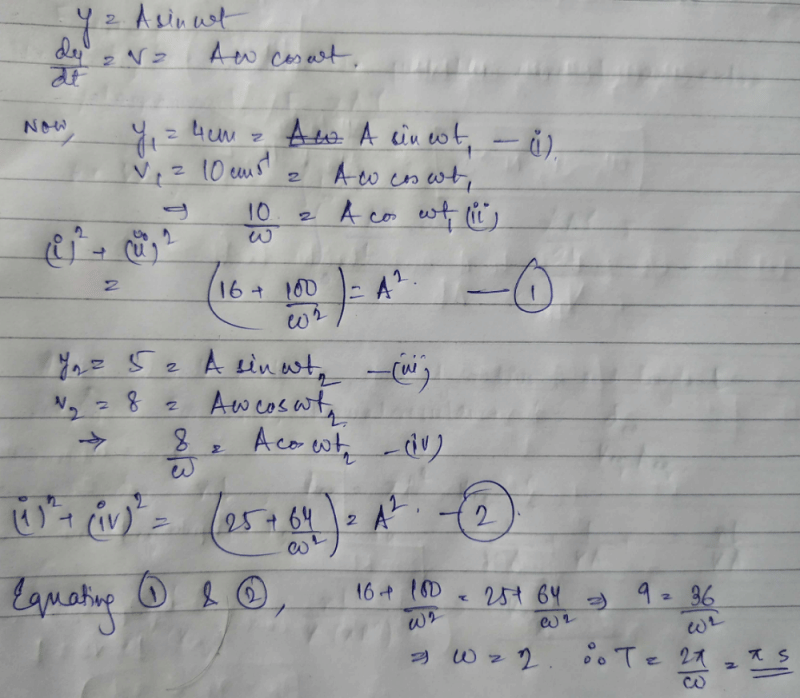
Three masses of 500 g, 300 g and 100 g are suspended at the end of an ideal spring as shown and are in equilibrium. When the 500 g mass is suddenly removed, the system oscillated with a period of 2 s. When 300 g mass is also removed, it will oscillate with the period- a)1.75 s
- b)1.25 s
- c)1.5 s
- d)1 s
Correct answer is option 'D'. Can you explain this answer?
Three masses of 500 g, 300 g and 100 g are suspended at the end of an ideal spring as shown and are in equilibrium. When the 500 g mass is suddenly removed, the system oscillated with a period of 2 s. When 300 g mass is also removed, it will oscillate with the period
a)
1.75 s
b)
1.25 s
c)
1.5 s
d)
1 s

|
Tejas Joshi answered |
When 500 g is removed, m = (100 + 300)g = 0.4 kg
When 300 g is also removed,
Which one of the following statements is true for the speed v and the acceleration a of a particle executing simple harmonic motion ?- a)When v is maximum, a is zero [2004]
- b)When v is maximum, a is maximum
- c)Value of a is zero, whatever may be the value of v
- d)When v is zero, a is zero
Correct answer is option 'A'. Can you explain this answer?
Which one of the following statements is true for the speed v and the acceleration a of a particle executing simple harmonic motion ?
a)
When v is maximum, a is zero [2004]
b)
When v is maximum, a is maximum
c)
Value of a is zero, whatever may be the value of v
d)
When v is zero, a is zero
|
|
Surendra Bishnoi answered |
Phase differences between acceleration and velocity is always 90 so if one equation is express in terms of sin and other express in cos terms so if one maximum then other is minimum
The periodic time (tp) is given by- a)ω / 2 π
- b)2 π / ω
- c)2 π × ω
- d)π/ω
Correct answer is option 'B'. Can you explain this answer?
The periodic time (tp) is given by
a)
ω / 2 π
b)
2 π / ω
c)
2 π × ω
d)
π/ω
|
|
Divyansh Saha answered |
Periodic time is the time taken for one complete revolution of the particle.
∴ Periodic time, tp = 2 π/ω seconds.
∴ Periodic time, tp = 2 π/ω seconds.
Under forced oscillation, the phase of the harmonic motion of the particle and phase of driving force- a)Are same
- b)Are different
- c)Both are zero
- d)Not present
Correct answer is option 'B'. Can you explain this answer?
Under forced oscillation, the phase of the harmonic motion of the particle and phase of driving force
a)
Are same
b)
Are different
c)
Both are zero
d)
Not present
|
|
Pratibha Sharma answered |
Harmonic motion is the natural motion of a body(we consider no air friction) under no force where as damped oscillation are under force hence the iscilation are different
A particle is executing a simple harmonic motion of amplitude a. Its potential energy is maximum when the displacement from the position of the maximum kinetic energy is [2002]- a)0
- b)±a
- c)±a /2
- d)– a/2
Correct answer is option 'B'. Can you explain this answer?
A particle is executing a simple harmonic motion of amplitude a. Its potential energy is maximum when the displacement from the position of the maximum kinetic energy is [2002]
a)
0
b)
±a
c)
±a /2
d)
– a/2

|
Alina Yadav answered |
PE is maximum at extremes where y is equal to a
Two particles are oscillating along two close parallel straight lines side by side, with the same frequency and amplitudes. They pass each other, moving in opposite directions when their displacement is half of the amplitude. The mean positions of the two particles lie on a straight line perpendicular to the paths of the two particles. The phase difference is [2011M]- a)0
- b)2π/3
- c)π
- d)π/6
Correct answer is option 'B'. Can you explain this answer?
Two particles are oscillating along two close parallel straight lines side by side, with the same frequency and amplitudes. They pass each other, moving in opposite directions when their displacement is half of the amplitude. The mean positions of the two particles lie on a straight line perpendicular to the paths of the two particles. The phase difference is [2011M]
a)
0
b)
2π/3
c)
π
d)
π/6
|
|
Rajeev Saxena answered |
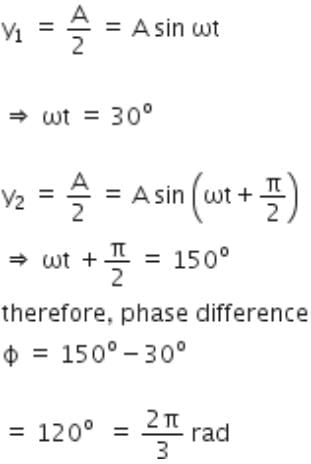
Two simple pendulums of length 1m and 25 m, respectively, are both given small displacements in the same direction at the same instant.If they are in phase after the shorter pendulum has completed n oscillation, n is equal to - a)4/3
- b)5/4
- c)7/5
- d)8/7
Correct answer is option 'B'. Can you explain this answer?
Two simple pendulums of length 1m and 25 m, respectively, are both given small displacements in the same direction at the same instant.If they are in phase after the shorter pendulum has completed n oscillation, n is equal to
a)
4/3
b)
5/4
c)
7/5
d)
8/7

|
Arya Reddy answered |
∴ T ∝ √L , as time period decreases when the length of pendulum decreases, the time period of shorter pendulum (Ts) is smaller than that of longer pendulum (Tl). That means shorter pendulum performs more oscillations in a given time.
It is given that after n oscillations of shorter pendulum, both are again in phase. So, by this time longer pendulum must have made (n – 1) oscillations.
So, the two pendulum shall be in the same phase for the first time when the shorter pendulum has
completed 5/4 oscillation
completed 5/4 oscillation
Chapter doubts & questions for Oscillations - Topic-wise MCQ Tests for NEET 2025 is part of NEET exam preparation. The chapters have been prepared according to the NEET exam syllabus. The Chapter doubts & questions, notes, tests & MCQs are made for NEET 2025 Exam. Find important definitions, questions, notes, meanings, examples, exercises, MCQs and online tests here.
Chapter doubts & questions of Oscillations - Topic-wise MCQ Tests for NEET in English & Hindi are available as part of NEET exam.
Download more important topics, notes, lectures and mock test series for NEET Exam by signing up for free.

Contact Support
Our team is online on weekdays between 10 AM - 7 PM
Typical reply within 3 hours
|
Free Exam Preparation
at your Fingertips!
Access Free Study Material - Test Series, Structured Courses, Free Videos & Study Notes and Prepare for Your Exam With Ease

 Join the 10M+ students on EduRev
Join the 10M+ students on EduRev
|

|
Create your account for free
OR
Forgot Password
OR
Signup on EduRev and stay on top of your study goals
10M+ students crushing their study goals daily






